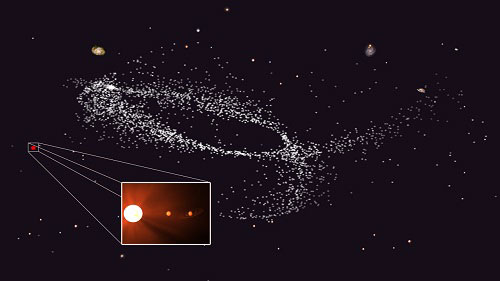| Jun 05, 2014 |
Two planets orbit nearby ancient star
|
|
(Nanowerk News) An international team of astronomers, including five Carnegie scientists, reports the discovery of two new planets orbiting a very old star that is near to our own Sun. One of these planets orbits the star at the right distance to allow liquid water to exist on its surface, a key ingredient to support life. Their work is published by Monthly Notices of the Royal Astronomical Society "Two planets around Kapteyn's star : a cold and a temperate super-Earth orbiting the nearest halo red-dwarf").
|
 |
| Kapteyn's star and its planets likely come from a dwarf galaxy now merged with the Milky way. The bottom right panel shows characteristic streams of stars resulting from such a galactic merging event. (The image is courtesy of Victor Robles, James Bullock, and Miguel Rocha at University of California Irvine and Joel Primack at University of California Santa Cruz)
|
|
Kapteyn’s Star, named after the Dutch astronomer, Jacobus Kapteyn, who discovered it at the end of the 19th century, is the second fastest-moving star in the sky and belongs to the Galactic halo, an extended group of stars orbiting our Galaxy on very elliptical orbits. With a third of the mass of the Sun, this red-dwarf can be seen with an amateur telescope in the southern constellation of Pictor.
|
|
The astronomers—including Carnegie’s Pamela Arriagada, Paul Butler, Steve Shectman, Jeff Crane, and Ian Thompson—used new data from the HARPS spectrometer at the European Southern Observatory's La Silla observatory, the Planet Finding Spectrometer at the Magellan/Las Campanas Observatory in Chile, and the HIRES spectrometer at the W.M. Keck Observatory in Hawaii to measure tiny periodic changes in the motion of the star. The Doppler Effect enabled the scientists to deduce some properties of these planets, including their masses and orbital periods.
|
|
“That we can make such precise measurements of such subtle effects is a real technological marvel,” said Jeff Crane of the Carnegie Observatories.
|
|
“We were surprised to find planets orbiting Kapteyn’s star. Previous data showed some irregular motion so we were looking for very short period planets when the new signals showed up loud and clear,” explains lead author Dr. Guillem Anglada-Escude, a former Carnegie postdoc now the Queen Mary University of London.
|
|
The planet called Kapteyn b might support water. It is at least five times the mass of that of Earth and orbits its star every 48 days. This means the planet is warm enough for water to be present on its surface. The second planet, Kapteyn c is a more massive super-Earth in comparision. Its year lasts for 121 days and astronomers think it’s too cold to support liquid water. At the moment, only a few properties of the planets are known: approximate masses, orbital periods, and the distances from their host star. By measuring their atmospheres using instruments that are currently under development, astronomers will verify the presence or lack of water.
|
|
“Finding a stable planetary system with a potentially habitable planet orbiting one of the very nearest stars in the sky is mind blowing. This is one more piece of evidence that nearly all stars have planets, and that potentially habitable planets in our Galaxy are as common as grains of sand on a beach,” said Pamela Arriagada, the second author, and a Carnegie postdoctoral researcher.
|
|
The planetary systems detected by NASA's Kepler mission are usually hundreds of light years away. In contrast, Kapteyn's Star is the 25th nearest star to the Sun—only 13 light years away from Earth. What makes this discovery special, however, is the peculiar story of the star. Kapteyn's Star is thought to have been born in a dwarf Galaxy that was long ago disrupted and absorbed by the Milky Way. This galactic cannibalization set the star on a new path, making it part of the Milky Way’s halo.
|
|
|
|
The likely remnant core of the original dwarf galaxy is Omega Centauri, an enigmatic group of stars 16,000 light years from Earth that contains hundreds of thousands of similarly old suns and was long thought to be a globular cluster. This sets the most likely age of Kapteyn’s Star and its planets at 11.5 billion years, which is 2.5 times older than Earth and “only” 2 billion years younger than the Universe itself (which has been measured to be 13.7 billion years old).
|
|
Dr Anglada-Escude adds: “It does make you wonder what kind of life could have evolved on those planets over such a long time.”
|

